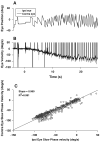The conjugacy of the vestibulo-ocular reflex evoked by single labyrinth stimulation in awake monkeys
- PMID: 20820761
- PMCID: PMC3089947
- DOI: 10.1007/s00221-010-2403-3
The conjugacy of the vestibulo-ocular reflex evoked by single labyrinth stimulation in awake monkeys
Abstract
It is well known that the vestibulo-ocular reflex (VOR) is conjugate when measured in the dark with minimal vergence. But the neural basis of the VOR conjugacy remains to be identified. In the present study, we measured the VOR conjugacy during single labyrinth stimulation to examine whether the VOR conjugacy depends on reciprocal stimulation of the two labyrinths. There are conflicting views on this issue. First, since the vestibular signals carried by the ascending tract of Deiters' are distributed exclusively to the motoneurons of the ipsilateral eye, the neural innervations after single labyrinth stimulation are not symmetrical for the two eyes. Thus, single labyrinth stimulation may generate disjunctive VOR responses. Second, the only published study on this issue was an electrooculography (EOG) study that reported disjunctive VOR responses during unilateral caloric irrigation (Wolfe in Ann Otol 88:79-85, 1979). Third, the VOR during unilateral caloric stimulation performed in clinical vestibular tests is routinely perceived to be conjugate. To resolve these conflicting views, the present study examined the VOR conjugacy during single labyrinth stimulation by recording binocular eye position signals in awake monkeys with a search coil technique. In contradiction to the previous EOG study and the prediction based on the asymmetry of the unilateral brainstem VOR circuits, we found that the VOR during unilateral caloric irrigation was conjugate over a wide range of conditions. We conclude that the net neural innervations received by the two eyes are symmetrical after single labyrinth stimulation, despite the apparent asymmetry in the unilateral VOR pathways. A novel role for the ascending tract of Deiters' in the VOR conjugacy is proposed.
Figures



Similar articles
-
Inputs from the ipsilateral and contralateral vestibular apparatus to behaviorally characterized abducens neurons in rhesus monkeys.J Neurophysiol. 1995 Dec;74(6):2445-59. doi: 10.1152/jn.1995.74.6.2445. J Neurophysiol. 1995. PMID: 8747205
-
Implications of noise and neural heterogeneity for vestibulo-ocular reflex fidelity.Neural Comput. 2008 Mar;20(3):756-78. doi: 10.1162/neco.2007.09-06-339. Neural Comput. 2008. PMID: 18045014
-
Galvanic ocular vestibular evoked myogenic potentials provide new insight into vestibulo-ocular reflexes and unilateral vestibular loss.Clin Neurophysiol. 2009 Mar;120(3):569-80. doi: 10.1016/j.clinph.2008.12.001. Epub 2009 Mar 9. Clin Neurophysiol. 2009. PMID: 19269890
-
[Central oculomotor circuits].Rev Neurol (Paris). 1985;141(5):349-70. Rev Neurol (Paris). 1985. PMID: 3901182 Review. French.
-
Plasticity in the vestibulo-ocular and optokinetic reflexes following modification of canal input.Rev Oculomot Res. 1985;1:145-53. Rev Oculomot Res. 1985. PMID: 3940026 Review.
References
-
- Arai Y, Yakushin SB, Cohen B, Suzuki JI, Raphan T. Spatial orientation of caloric nystagmus in semicircular canal-plugged monkeys. J Neurophysiol. 2002;88:914–928. - PubMed
-
- Baker R, Highstein SM. Vestibular projections to medial rectus subdivision of oculomotor nucleus. J Neurophysiol. 1978;41(6):1629–1646. - PubMed
-
- Chen-Huang C, McCrea RA. Viewing distance related sensory processing in the ascending tract of deiters vestibulo-ocular reflex pathway. J Vestib Res. 1998;8:175–184. - PubMed
-
- Evinger LC, Fuchs AF, Baker R. Bilateral lesions of the medial longitudinal fasciculus in monkeys: effects on the horizontal and vertical components of voluntary and vestibular induced eye movements. Exp Brain Res. 1977;28(1–2):1–20. - PubMed
-
- Formby C, Robinson DA. Measurement of vestibular ocular reflex (VOR) time constants with a caloric step stimulus. J Vestib Res. 2000;10:25–39. - PubMed
Publication types
MeSH terms
Grants and funding
LinkOut - more resources
Full Text Sources

